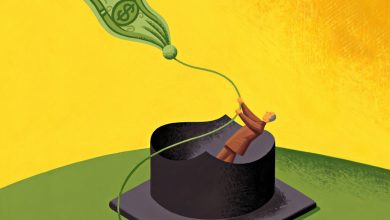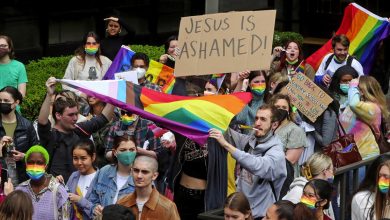What a 1960s Housewife Can Teach Us About Politics in Higher Ed

[ad_1]
The story went like this: One day, a police officer stationed near the University of South Florida’s campus watched as a car zoomed through a stop sign and barreled across a busy highway. When he caught up to the car, he found the driver overcome with emotion, tears running down her face.
Why was she so upset?
In Smith’s telling, the woman was “practically hysterical” over what she was being taught at USF. She told the cop that the university “would destroy the things she had built her very life on.”
“This,” Smith observed, “could have cost her life or that of someone else.”
The story, on its face, is absurd. Even the most rousing of lectures is unlikely to provoke reckless driving. But it was persuasive to Smith, whose son was a student at USF, then a brand-new university. She and other parents were already incensed by what they considered the anti-religious teaching at the institution and its coziness with Communism. They brought those complaints to Florida lawmakers, helping thrust USF into an existential crisis over what could and should be taught at a state-supported university.
“The question is, are we to have academic freedom without responsibility, without restraint? If so then it is not true academic freedom. It is an imitation of it,” Smith wrote in a lengthy report documenting her views.
In a note to a Florida representative, she was more aggressive. “Do I want my sons and daughters indoctrinated in the belief that there exists no right or wrong, no morality or immorality, no God, that family life has failed, that premarital relations are good, that homo-sexuality is fine? And then told, in the name of academic freedom it’s none of your business? … Then I say the parents should have unlimited freedom, even if it means seeing the professors — flattened on the floor!”

State Archives of Florida
Smith had dramatic flair. But the general thrust of her argument has pulsed like an electric current through the modern history of higher education: Out-of-control liberal professors infect impressionable young people with dangerous ideas, distorting their views of what the country has been, is, and should be. But other sensibilities — like those of parents, who pay tuition, or lawmakers, who hold purse strings — also matter when it comes to curricula at public institutions. Therefore, there must be constraints on what an instructor can teach, for the sake of the students and for the sake of America.
Over the past two years, that argument has been resurrected in the form of bills that restrict how faculty members (and schoolteachers) can teach race and racism. Critics of the measures, including free-speech organizations, contend that the legislation erects political barriers where there should be none, impeding faculty members’ ability to determine their course content as they see fit.
But supporters of the bills, including Florida’s Republican governor, Ron DeSantis, argue they’re necessary curtailments of leftist indoctrination. Florida tax dollars will not go toward “teaching kids to hate our country or to hate each other,” DeSantis said in a 2021 news release announcing one such bill.
By examining one historical precedent to such arguments — specifically the saga that engulfed Smith and the University of South Florida — we can see this moment with fresh eyes. Today, the professoriate is in some ways better positioned to fight back than it was in the mid-1900s. Many faculty members are doing just that. Yet these bills are being introduced during a bout of public distrust of professors and what they teach. And some colleges have urged their faculty members to err on the side of caution. The contours of academic freedom are, once again, hotly contested.
Amid those and other attacks, college leaders had to determine to what lengths they would go to protect academic freedom on their campuses. Until the mid-20th century, the “Gentleman Scientist Model” was in vogue, John K. Wilson writes in his dissertation, “A History of Academic Freedom in America.” Under that model, safeguarding academic freedom “depended upon the good faith of honorable administrators following unwritten academic norms.”
But honor and unwritten norms proved insufficient during the McCarthy era — a period of loyalty oaths, speaker bans, and intense persecution of leftists, including college professors. Though in only a handful of instances did the academic institution instigate the dismissal, colleges acquiesced in terminating scores of professors who were identified by government groups as objectionable, the historian Ellen Schrecker chronicles in her book No Ivory Tower: McCarthyism and the Universities. The American Association of University Professors also fell down on the job, issuing no investigative reports from 1950 through 1955, at the height of the fervor.
“The academy did not fight McCarthyism,” Schrecker writes. “It contributed to it.”
In the wake of those purges, and after the failure of the higher-ed establishment to defend its faculty, many academics believed they needed to be more aggressive in protecting their rights. What Wilson calls the “Liberty Model” was born. That model, which arose over years of struggle and debate, represented “a much broader sense of academic freedom, in which professors were free to express their ideas on all political issues,” he writes, “even if it offended critics and embarrassed their institutions.”
Of course, there were always criticisms, especially from conservatives. In his 1951 book God and Man at Yale: The Superstitions of “Academic Freedom,” William F. Buckley Jr. argued that “honest and discerning scholars” must “cease to manipulate the term academic freedom for their own ends.” Rather, it “must mean the freedom of men and women to supervise the educational activities and aims of the schools they oversee and support.” Or, put simply, those who pay should set the agenda. Those on the payroll should fall in line.
In the midst of this ideological tug-of-war, the Florida Legislative Investigation Committee was born. A late-stage Southern offshoot of McCarthyism, the committee was set up in 1956 to investigate “all organizations whose principles or activities … would constitute violence, or a violation of the laws of the state.” Lawmakers initially had integration in mind, but the committee soon became a roving attack dog that hunted for evidence of Communism and homosexuality in state institutions, including Florida’s public universities.
The committee, nicknamed the Johns Committee after its architect, State Sen. Charley Johns, and its investigators interrogated students, professors, and staff members, often alone and under the implicit threat that resistance would be pointless. Some professors suspected of having engaged in homosexual activity were forced out of the University of Florida. The academic climate in the state chilled considerably. Leaders of the committee “rationalized that ‘decency’ itself was at risk,” write two scholars, Thomas V. O’Brien and Jennifer Paul Anderson, in a paper.
The Johns Committee thought decency was particularly imperiled at the University of South Florida. Lawmakers trained their eyes on the campus in 1962. A group of parents organized by Smith informed the committee of its concern that professors were introducing vulgar or sacrilegious materials or touting Communism and socialism in the classroom. At the heart of their complaint was the belief that academic freedom for professors had gone too far, infringing on the rights of students to learn freely, and that it now threatened democracy.
“Should the moral laws of our universe be repealed by the professors in their demand for academic freedom?” Smith wrote in her report. “They may call it academic freedom. Others call it national suicide!”
For the Johns Committee, too, academic freedom’s ripeness for abuse was concerning. Lawmakers conducted hearings on campus of students, professors, administrators, and the university president. Though the committee’s chief counsel, Mark Hawes, acknowledged that academic freedom is “a fundamental principle … that education rests on,” legislators nevertheless disparaged certain reading materials, like a short story by J.D. Salinger. They asked how far academic freedom extended, particularly when it came to Communism. “Would it include the bringing of a member of the Communist Party here to speak on the subject of Communism, or democracy, or the isms, generally?” Hawes asked the dean of student affairs. (That’s “a very leading question,” the dean replied.)
The committee’s eventual conclusion was scathing. Yes, academic freedom had been “the very backbone” of any educational institution, Hawes told the 1963 Legislature, according to one archived rendering of his speech. However, the term was now being used to mean that educators could “run these schools without restraint of policy at all from the people or their elected representatives.”
That sort of academic freedom covers the right “to teach as they please in a state-supported school in regard to religion,” Hawes continued, clearly indignant. “… It includes the right to teach there is no right and no wrong. It includes the right to take this ordinary, everyday filth, which I call intellectual garbage, off the newsstands and put it in the classroom as required text.”
The committee did not stop at a public harangue. In 1965 it proposed an “academic freedom bill” that regulated campus speakers as well as professors’ speech and actions. According to a copy of the bill in the state’s records, it would have, among other things, required the state’s Board of Education to adopt regulations banning any higher-education employee or organization from advocating, “by word or deed,” the willful disobedience of state or national laws.
But by the time the bill was on the table, Floridians had been grappling with what it would mean for politicians to regulate professors’ speech and course content. As one USF dean observed, the Johns Committee ordeal had provoked a fundamental question: “Does the state wish to develop distinguished universities where all aspects of the truth may be pursued without fear or favor? Or does it wish to develop a group of glorified finishing schools in which scholars are unable to pursue their honest lines of inquiry or to stimulate students into creative and unfettered thinking?”
Florida citizens seemed to gravitate toward the former. Though some agreed with the committee’s actions at USF, many others — as evidenced by newspaper articles and editorials, committee records, and archived correspondence — saw its inquest as a major misstep. John S. Allen, USF’s president, defended his new university against the committee’s charges and argued in favor of diversity of thought. “Our purpose is to educate, not indoctrinate; to help students learn how to think, not what to think,” he said in a press statement.
Many citizens agreed with Allen and rallied to his defense. “I just want to be counted on the record as deploring this present ‘witch hunt’ on the campus,” one woman wrote to the university. Wrote another, to Allen: “I wish to assure you that as the mother of one of your students I heartily concur with the teaching methods and materials used by the professors.” Some Floridians worried that should their state not protect academic freedom, some gifted professors would resign, and others would be discouraged from accepting jobs at Florida institutions.
Florida faculty members also made the case for academic freedom publicly, arguing it was necessary to society even though, as one professor acknowledged, it could be uncomfortable. “Nothing grows without the signs of cracking, without the snap of bark, without unlovely skin peeling,” wrote the University of Florida historian C.K. Yearley in an open letter to Florida citizens and parents, published in the press.
Yearley continued: “You have an option, of course. You can cease to grow. I will not cease to grow with you. I will move on. And others will follow and you will have great husks of brick and steel and concrete. You may derive some satisfaction from that. But you will in the estimate of thinking men have nothing but a great investment in husks.”
The academic-freedom bill died a quick death. Nearly nine years after its inception, the committee folded, too. But not before leaving a score of college employees without their jobs after they were accused of homosexual conduct. Virtually no one rallied to those employees’ defense. In that way, said Wilson in an email, the Johns Committee period reflects the “darker side of the history of academic freedom in America” — one of “straight white male professors leaving behind disempowered groups in order to carve out a narrow idea of academic freedom that would protect themselves.” Yet when the committee expanded its attack and waged a campaign against the fundamental principles of higher education, that proved to be too drastic. The committee, which suffered from several scandals, eventually lost the support of the public. USF, though weary from the fight, was still standing.
It’s possible to see today’s bills that restrict instruction about race and racism as an extension of that same impulse. It’s no coincidence, said Jeremy C. Young, senior manager for free expression and education at PEN America, that the bills arose after the murder of George Floyd and the publication of The New York Times’s 1619 Project, at a moment when the country seemed poised for a racial reckoning.
Sponsors and supporters of the bills would dispute that interpretation. During a legislative hearing in January, Bryan Avila, a Florida Republican representative, presented one such measure, HB 7, saying that “nothing in this bill bans the teaching of historical facts about slavery, sexism, racial oppression, racial segregation, and racial discrimination.” He referred to his experience as an adjunct who taught a government course at Broward College, in southern Florida. At “no point” did he “inject any sort of political or ideological belief on a particular topic of discussion,” he said. (Avila did not respond to an emailed interview request.)
Regardless of what motivated the bills, they have proved popular among conservative state lawmakers, if not as popular with the public. According to PEN America, nearly 200 such bills, which the organization calls “educational gag orders,” were filed across the country in 2021 and 2022. Nineteen have become law, seven of which apply to higher education. This year, there has been “an increase in the complexity and scale of legislation, as lawmakers have sought to assert political control over everything from classroom speech to library content, from teachers’ professional training to field trips and extracurricular activities,” the organization wrote in a recent report.
Each historical moment has its own context, its own actors. But the rhetorical parallels between the Johns Committee period and today “are just stunning,” Young said. “Here we are fighting this battle,” he said, “and it’s a battle that’s been fought many, many times before.”
Take, for example, recent events in Texas. In late 2021, faculty governing bodies across the country began taking public stances against the bills. In February 2022, the University of Texas at Austin’s Faculty Council passed a resolution affirming that “educators, not politicians, should make decisions about teaching and learning.” The state’s lieutenant governor, Dan Patrick, a Republican, rejected that idea. “Hiding behind this academic-freedom argument just doesn’t work,” he said at a news conference.
“We believe in academic freedom,” Patrick said. “But everyone has guidelines in life. Everyone has barriers.” He then said he planned to propose ending tenure for all new hires and threatened to rescind tenure for faculty members who teach critical race theory.
There are notable differences between the eras. During the McCarthy fervor, individual scholars were targeted, but the college classroom went untouched, though many academics began dropping controversial topics from their curricula, according to Schrecker, the historian of McCarthyism.
In the mid-20th century, skepticism about the value of academic freedom was broader, Wilson said in a phone interview. Now, it seems fewer people openly denounce the concept.
But there’s also a growing view among conservatives that universities are “captive to their enemies — not just containing radicals but being run by radicals,” Wilson said. “That’s language you didn’t hear in the ’50s and ’60s.” Which is not to say that criticism of faculty members as radicals has gone away. Nearly 80 percent of Republican and Republican-leaning respondents who said they think the higher-education system is headed in the wrong direction cited professors’ bringing their political and social views into the classroom as a major reason, according to a 2018 Pew Research Center survey.
Professors are also much more organized than they were during the 1950s and 1960s, and more likely to speak out — at least those with job security. The instruction bans have sparked a wave of faculty opposition, particularly in Florida. Florida International University’s faculty union launched a Freedom to Teach/Freedom to Learn campaign. It held a teach-in on academic freedom, has told professors they don’t need to change how they teach because of the law, and is attempting to build political connections with teachers across the state who face similar restrictions and are natural allies, said Eric Scarffe, vice president of the union.
HB 7, the Florida law, has also been challenged in court by professors, among other groups. The law says in part that students cannot be subjected to instruction that “espouses, promotes, advances, inculcates, or compels” them to believe certain “concepts,” including that the values of “objectivity” or “racial colorblindness” are “racist or sexist, or were created by members of a particular race, color, national origin, or sex” to oppress other such groups. If a university is found to have committed a “substantiated violation” of HB 7, it will not receive performance funding the following fiscal year, according to a separate law passed by Florida lawmakers.
In one suit, lawyers representing LeRoy Pernell, a law professor at Florida A&M University, and other plaintiffs argued that complying with HB 7 “would directly conflict with a core tenet of his pedagogy: the idea that the legal system is not, and has never been, race-neutral … He thus fears that the Act will restrict his ability to effectively teach his courses and foster discussion on important topics — like systemic racism in the legal system — and to prepare his students to be successful lawyers and advocates.”
In defending the measure in court, lawyers representing the state argued that professors do not have an individual right to academic freedom. Rather, that right, to the extent it exists, belongs to universities and extends only to their autonomy from the judiciary, not from “the state that chartered it, governs it, and provides its funding,” reads the filing. The idea that individual professors “have a constitutional right to make their own decisions, free from interference by anyone, whether university administrators or the state itself, concerning what may be taught and how it shall be taught would be a recipe for educational chaos,” it says, “not excellence.”
Much remains to be seen about how colleges will interpret the laws, and if and how academic freedom will be redefined on campus. Initial signs trouble critics. A North Florida College PowerPoint presentation about HB 7, obtained by the Foundation for Individual Rights and Expression through a public-records request, includes hypothetical classroom scenarios. In discussing Jim Crow laws, can a professor “make a sweeping statement that white people were responsible” for enacting them? No, the slide says, the instructor should avoid blaming a particular race, “though exploring the motives of the specific individuals that enacted such laws would be permitted.”
A guide for faculty members and deans at Valencia College, also obtained by FIRE, notes that while the “use of double negatives in the wording” of one of the concepts makes it difficult to know what is banned, “a critique of colorblindness or insistence on identity consciousness could constitute discrimination” under the law.
In a recent paper analyzing the possible effects on law-school classrooms, Katheryn Russell-Brown, a law professor at the University of Florida, writes that faculty members will ultimately decide for themselves how to comply with HB 7. Those who teach courses on topics that are not typically thought of as “race-centered” may avoid those issues altogether, she writes, determining that teaching about race is “at best unattractive and at worst dangerous, as it would bring unwanted scrutiny.”
In America, the desire for censorship in public education comes in waves. There are fevers, PEN America’s Young said, and then they break, typically not on their own. The McCarthy era, and the Johns Committee, was one such fever. To Young, this is another, and he’s not sure when it will subside.
For now at least, what curriculum is appropriate for college students, and who should decide, remains an active national argument. Sentences that Jane Tarr Smith, the concerned USF parent who died in 2002, wrote six decades ago still resonate:
“We know that as the student goes, so goes the nation,” she said. “Hence, our grave concern over the teachings they receive.”
[ad_2]
Source link







